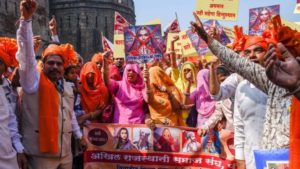Post ”˜Padmaavat’ ”“ A time of reckoning.

By Sudha Kumar.
So the reality of Padmavati, rebaptised ”˜Padmaavat’, is laid bare.
What was the fury and furore about, one wonders?
Waited for the movie. Watched it. And felt let down.
All that emotional energy that the country reeled in for weeks. Buses burnt and calls for beheadings and lynching. Rajput nobility crossing their royal threshold with war cries. Because somehow it was perceived that they, with the blessings of a very powerful establishment, were the keepers of the ”˜epitome of virtue’ that was Rani Padmini.
But as Bhansali’s Padmavati broke royal ranks and swirled her numerous ghoomars, Rajput pride and honour was well protected behind the digital veil covering her midriff. (Thanks VFX).
The movie has little to offer in terms of stimulating thought, save some spectacular visuals. As much as the act was and is understood as one of defiant valour, courage and sacrifice, there was hardly any constructive build up to the ”˜jauhar’.
Deepika Padukone barely had a presence beyond the beautiful physical, and Ranvir Singh tried his best to make up for it. The pleats and folds of yards of exquisite material that adorned the characters, and the walls of the spectacular royal household, portrayed the paradigm of a then misogynistic and masochistic time. One strains to see a message in the story, if nothing at least of unrequited love, nay obsession.
And so Padmavati and Padmaavat are laid to rest, as Bhansali rakes in the ”˜moolah’.
But the question begs to be asked. Again.
What was the fury about?
Did it have anything to do with excesses of artistic licence or distortion of hitherto unproven historical events? Or was it just the display of power of the self-declared fringe force vigilantes, the ”˜moral police’ which vandalises, incites emotional reaction, and rejects expression or diversity of any kind unless it is within the frame of their perspective? And is enabled by power.
One finds it difficult to ignore the numerous social indicators where religion is entwined with political power and methodically validated in India today. A religion is defined by its ideology that sits at its very core, high above the rituals, traditions, practices, and processions. When it then aligns with political power, that core erodes, and then religion ceases to be. It just becomes a camouflage for an organization that continually needs to prove its religious identity. There is hardly a religious group anywhere that would abstain from fostering a relationship with state power to their advantage, but it is extremely dangerous when it is a majority religion that entrenches itself in the power of governance.
Western Christianity and global Islam are examples of religions that aligned themselves with political powers. Jesus Christ died a victim of that very alignment. Catholic Christianity saw Popes become ”˜Superpopes’. Today Western Christianity sits neatly ”˜fissioned’ from political power, but only after historical upheaval and turmoil over many centuries which contradicted the very principles of Christ. History taught and they learnt. Global Islam still struggles. Islamic theocratic states today are testimony to the fact that religion should have no power other than power of faith.
It is indeed a time for reckoning in India. Secularism in India understood and practiced as a form of pluralism, is today challenged. The fact is, when power of governance finds an ally in religion it corrupts both. And so religion based vote banks become an inevitable by-product. In a democracy power is but the consequence of votes.
And as State power ascends, even the Gods find themselves to have become back benchers.
Short URL: https://indiandownunder.com.au/?p=10534
